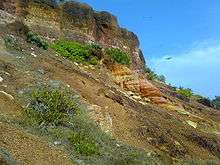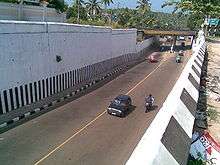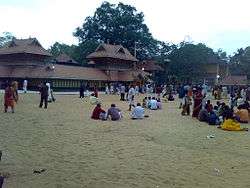Chirayinkeezhu taluk
| Chirayinkeezhu taluk | |
|---|---|
| taluk | |
 Chirayinkeezhu taluk Location in Kerala, India | |
| Coordinates: 8°42′N 76°49′E / 8.70°N 76.82°ECoordinates: 8°42′N 76°49′E / 8.70°N 76.82°E | |
| Country |
|
| State | Kerala |
| District | Thiruvananthapuram |
| Headquarters | Attingal |
| Government | |
| • Body | Gram panchayat |
| Languages | |
| • Official | Malayalam, English |
| Time zone | IST (UTC+5:30) |
| Telephone code | 0470 |
| Vehicle registration | KL-01 , KL-16 |
Chirayinkeezhu Taluk is a Taluk (tehsil) in Thiruvananthapuram district in the Indian state of Kerala.[1] It is situated in the northern part of the Thiruvananthapuram district. It comprises 29 villages and two municipalities. Chirayinkeezhu taluk is the birthplace of a host of illustrious personalities like the painter Raja Ravi Varma, the great poet and social reformer Kumaran Asan, the practical saint and sanyasin Sree Narayana Guru, Prem Nazir etc.
Settlements
There are 29 villages and two municipalities are in the taluk.[2]
Villages
Alamcode, Ayiroor, Azhoor, Chemmaruthy, Cherunniyoor, Chirayinkeezhu, Edakkode, Edava, Kadakkavoor, Karavaram, Keezhattingal, Kilimanoor, Ponganadu, Koonthalloor, Koduvazhannoor, Kudavoor, Madavoor, Manamboor, Mudakkal, Nagaroor, Navaikulam, Ottoor, Pallickal, Pazhayakunnummel, Perunguzhi, Pulimath, Sarkara-Chirayinkeezhu, Vakkom, Vellalloor, Vettoor·[3]
Municipalities
There are two municipalities: Varkala and Attingal.
Places of tourist interest
Chirayinkeezh has a network of backwaters and canals, which is quite typical of Kerala. Also there are many Temples and important tourist places. Some of them are given below.
Varkala
Varkala, a coastal town famous for the Papanasam beach, is around 50 km (31 mi) north of Thiruvananthapuram and 37 km (23 mi) south of Kollam. Once a quiet coastal hamlet, today it is a bustling tourist spot with many resorts. Places of interest include the Sivagiri Mutt established by Sree Narayana Guru and the ancient Janardhanaswamy temple dedicated to Lord Vishnu.
Varkala Papanasam beach

Varkala Beach is a haven for sun-bathing and swimming. It is situated on Varkala. There are several small restaurants and snack shops near and around Papasnanam beach, which attracts visitors both for leisure as well as for religious reasons.
Sivagiri Mutt
Sivagiri Mutt was established by Sree Narayana Guru (1856–1928), a spiritual leader, renowned philosopher and social reformer of Kerala. Presently, the Sivagiri Mutt is the 'samadhi' (memorial/ final resting place) of Sree Narayana Guru. The Sivagiri Mutt, built in 1904, is situated at the top of the Sivagiri hill at Varkala. Even decades after the Guru breathed his last here in 1928, his samadhi continues to be visited by throngs of devotees, dressed in yellow attire, during the Sivagiri Pilgrimage days, 30 December to 1 January. The Sivagiri Mutt is also the headquarters of the Sree Narayana Dharma Paripalana Sangham, a religious organization established by the Guru to propagate his concept of 'One Caste, One Religion, One God'. The Guru Deva Jayanti, the birthday of the Guru, and the Samadhi day, the day of his demise, are celebrated in August and September respectively every year. Colourful processions, debates and seminars, public meetings, cultural shows, community feasts, group weddings and rituals mark the celebrations.
Sarkaradevi Temple
Sarkaradevi Temple is an ancient and one of the most important Devi temples in South India. Tradition accords a remote antiquity to this temple. Its main deity is Bhadrakali. The temple assumed a significant status and rose to historical importance mainly with the introduction of the famous 'Kaliyoot' festival by Anizham Thirunal Marthanda Varma, the Travancore sovereign, in 1748. In those days, with the Chirayinkeezhu Taluk being directly under the immediate administration of the Attingal Swarupam, the Attingal Ranis where entrusted by the Travancore Raja with the conduct of the elaborate festival of Kaliyoot. The Attingal Rani being related to the Travancore royal family through adoption from the Kolathunad royal family, had enjoyed independent rights in several respects over the neighbouring regions and temples and at times even over the entire Venad. Even when King Marthanda Varma annexed Attingal to Travancore soon after ascending the throne and decided to assume direct control over Attingal 'estate', the Ranis seem to have been allowed to continue in their independent status in many respects. Hence it was no wonder that when the former decided to introduce Kaliyoot festival in the Sarkaradevi Temple of Chirayinkeezhu Division, he entrusted the responsibility to the Attingal Ranis, even though the finances came directly from the Travancore royal treasury. The Attingal Ranis in turn bestowed the rights to the members of the martial family of Ponnara Panickers (When two princesses were adopted from Kolathunad, some senior members of the Ponnara Panicker family are said to have accompanied them as bodyguards to Attingal, where the former were settled by the Venad kings. The descendants of the Panicker family still reside there, and have the right of supervising the grand festival.) It is perhaps the only temple in South Kerala where an elaborate Kaliyoot festival is conducted. Another festival which draws the crowds of devotees and tourists is the ten-day Meenabharani festival in March-April every year.
Ponnumthurut Island
Ponnumthurut Island is a beautiful spot you can reach by cruise boat. It is situated near Varkala. There is a sivaparvathy Temple on this island.
References
- ↑ https://web.archive.org/web/20091108053235/http://trivandrum.gov.in/trivandrum/index.php/chirayinkeezh-citizen-services-389?task=view. Archived from the original on November 8, 2009. Retrieved April 23, 2010. Missing or empty
|title=(help) - ↑ Villages and municipalities Archived November 8, 2009, at the Wayback Machine.
- ↑ https://web.archive.org/web/20110713144207/http://www.keralahotels.com/new_site/thiruvananthapuram.html. Archived from the original on July 13, 2011. Retrieved April 23, 2010. Missing or empty
|title=(help)


